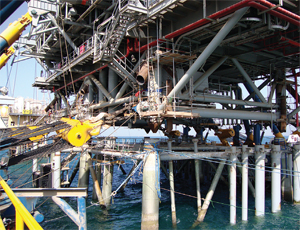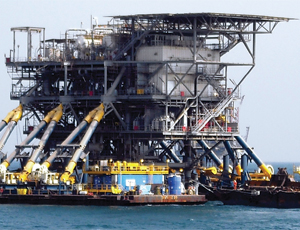Designing a custom system to lift and set 2,200-ton and 2,600-ton offshore platforms is notable enough. But Belle Chasse, La.-based Versabar Inc. had to work with three different cultures across nine time zones and sail past real-life pirates to a site 8,500 miles away to make its most recent job successful—all within 10 months.


Versabar was hired by Al Khafji Joint Operations to use its Versatruss system to lift the two largest platforms ever installed in the Persian Gulf for a 600,000-barrel-per-day field jointly operated by Saudi Arabia’s Aramco Gulf Operations and Kuwait Gulf Oil Co. Al Khafji received a $1.2-billion contract to design, build and install six offshore platforms. Versabar began in January and completed the job in November.
“The technical aspect wasn’t the most daunting part of this project,” says John Greeves, technical director and vice president of Versabar. From signing the contract to trying to get on the dock to move the decks to the Persian Gulf, everything had an added layer of work, he says.
But the clients were pleased. “It’s a good system and cost-effective,” says Ahmed Al Rayyis, one of the directors of the joint operation. “We’re very glad to have used it and to have our new facilities.” A semi submersible crane could have done the job, but none was available, he says.
The Cairo, Egypt-based contractor team includes Enppi, which designed the platforms, Petroleum Marine Services, which built the platforms in Alexandria, Egypt, and Petrojet, which installed the platforms. The decks were 80% complete when the contractors realized they did not have a way to lift the huge platforms and hired Versabar, says company President Jon Khachaturian.
The company built six Versatruss modules in Belle Chasse and installed them on two barges by May, dispatching them to the Persian Gulf. After a barge hired to move one of the decks was hijacked off the Gulf of Aden last spring, Khachaturian secured mercenaries and a gunboat to accompany the tugboats and the Versatruss system on the 70-day trip, which was completed without incident. None of Versabar’s staff went along on the journey.
The Versatruss system consists of two barges that connect to opposite sides of the deck with multiple lifting modules. Each lifting module contains a boom, which is the compression strut, a pair of blocks, which act as the tension chord, and a winch. The boom and blocks connect to a common heel pin, resulting in a pure vertical load along the longitudinal centerline of the catamaran-like barges.
The booms mate with pins that are preinstalled on an upper deck, while the blocks connect to a lower-level lifting point. To lift the deck, the blocks are drawn together using the winches. As the lower chord is shortened and the boom angle increases, the deck is raised through the “prying” action of the booms. Khachaturian says this was done once at dockside to test the lift and then again at the lift site, in about 110 ft of water.
At the lift site, once the deck was lifted clear of the transport barge, the Versatruss systems moved the deck over the jacket, with one barge on either side. The deck was set down by paying out the winches, allowing the blocks to separate, lengthening the lower chord and lowering the boom angle.
During each 10-day lift, teams of Versabar engineers in Texas and Louisiana watched real-time video of the work and were in constant phone contact with the installation crew, Khachaturian says.

Post a comment to this article
Report Abusive Comment